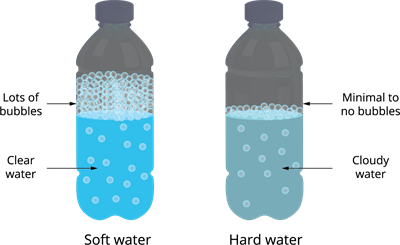
PUMPA - SMART LEARNING
எங்கள் ஆசிரியர்களுடன் 1-ஆன்-1 ஆலோசனை நேரத்தைப் பெறுங்கள். டாப்பர் ஆவதற்கு நாங்கள் பயிற்சி அளிப்போம்
Book Free DemoWe wash our clothes with soaps and detergents. They create a lather with water, which speeds up the process of removing dirt from clothing.
You might be heard or observed that soaps or detergents create less lather with water. This is due to the hardness of the water.
A variety of dissolved salts and minerals can be found in water. When there are many minerals and salts in the water, soaps and detergents form a thick scum instead of lather. Dirt removal becomes even more difficult as a result of this. Such water is called hard water. The calcium and magnesium salts in water determine the hardness.
Examples for hard water: Pond water, river water, seawater, and groundwater.
Hardness of water may be temporary or permanent.
Temporary hardness:
The presence of calcium and magnesium carbonate and bicarbonate salts cause temporary hardness.
Permanent hardness:
The presence of calcium and magnesium chloride and sulphate salts cause permanent hardness.
Soft water
Soft water is defined as water that has very small amounts of these salts and other minerals. Soaps or detergents easily form lather in this water.
Examples for soft water: Rainwater and distilled water.

Soft and hard water
Disadvantages of hard water:
- It is not suitable for the washing of clothes. It develops scum with soap and detergents, leaving the soap ineffective and further damaging the clothes.
- It deposits scales on industrial machine parts, reducing their efficiency.
- If we consume hard water for an extended period, it causes stomach problems.
- After washing your hand, you feel a film on your hands. This is due to the soap reacting with calcium to form soap scum. If the water is hard, you will need to rinse your hands longer.
- Spots can be seen on glasses and silverware that have just come out of the dishwasher. These are due to the deposit of calcium carbonate.
- Poor water pressure in taps. Mineral deposits can accumulate in pipes, reducing water flow by shrinking the internal diameter of the pipes.
Reference:
https://clearwaterarizona.com/wp-content/uploads/2019/08/hard-water4.jpg